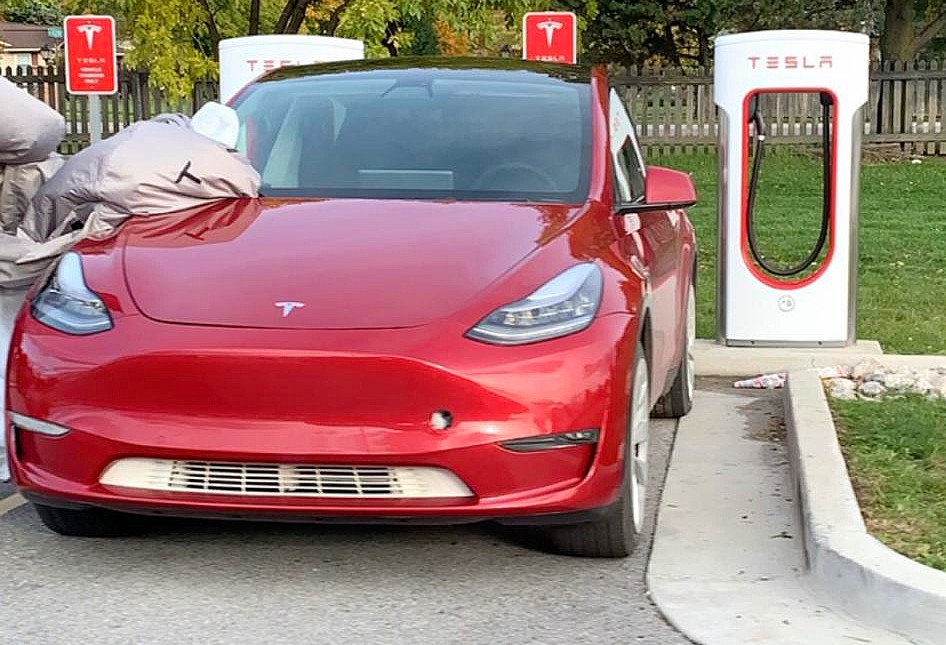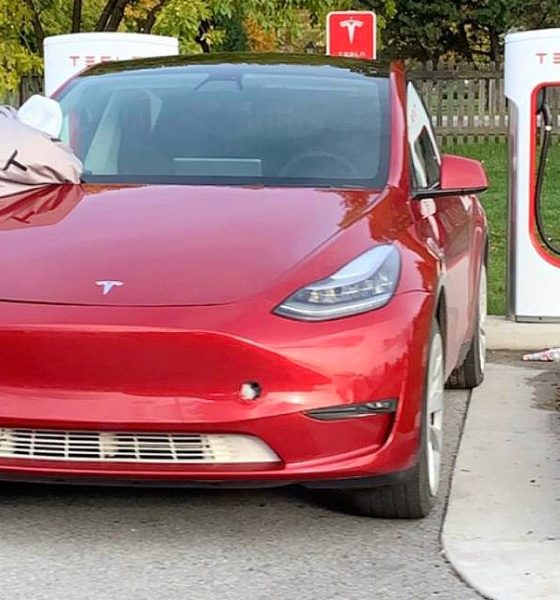

News
Tesla Model Y with Model S/X ‘Slipstream’ wheels spotted long range testing in MI
A Tesla Model Y has been spotted over 2,400 miles away from Fremont, CA, with an electric car enthusiast capturing a photo and video of the upcoming vehicle in Bay City, MI. Particularly interesting in the recent sighting were some components of the Model Y; namely, its wheels and front air intake.
Previous Model Y sightings have hinted at Tesla’s efforts to test its crossover SUV’s long-range capabilities. Over the past weeks, a Midnight Silver Model Y with Power Sports Aero Wheels was spotted in WA, and an all-black prototype was sighted in Columbus, OH, over 2,000 miles away from CA. This time around, a red Model Y was spotted in Bay City, MI, a location that is also a very long way away from Tesla’s Fremont factory and headquarters.
Tesla enthusiast and r/TeslaMotors subreddit member u/detroit_kp313 was able to film the all-electric crossover as it overtook him on a long stretch of road in the Bay City area. The Model 3 owner was also able to snap a photo of the vehicle while it was parked at a Supercharger. Through the Model 3 owner’s video and picture, several interesting aspects of the Model Y became noticeable.

For one, this particular unit was equipped with what appeared to be 19″ Slipstream wheels, which Tesla uses for its flagship vehicles, the Model S sedan and the Model X SUV. This is quite interesting, as the bolt pattern for the Model S/X and the Model 3 (which the Model Y is based on) seem to be a bit different.
While this could simply be due to Tesla using an adapter to fit Model S/X wheels on the Model Y, the presence of the parts in the upcoming vehicle suggests that the electric car maker is looking at different wheel options for the crossover SUV. This should provide some variety for the vehicle, which would likely be appreciated by Model Y buyers.
Apart from its curious set of wheels, the red Model Y prototype spotted in Bay City was also equipped with a front air intake that features a rather unusual tan color, making it appear almost like it was 3D printed. Of course, the component’s unusual color might simply be due to chance, but its appearance goes give the impression that Tesla is also testing different front air intake designs for the upcoming vehicle.
The Model Y is expected to compete in the crossover SUV segment, a market that pretty much dominates the auto industry today. Tesla has high expectations for the vehicle, with Elon Musk noting during the company’s Q3 2019 earnings call that he expects the Model Y to outsell the Model 3, Model S, and Model X combined. The Model Y was initially slated to start production in Fall 2020, though Tesla recently updated this target timeframe to Summer 2020 in its recently-released Q3 Update Letter.
Watch the Tesla Model Y with Model S/X Slipstream wheels whiz by in the video below.
Model Y in Bay City MI!!! from r/teslamotors

News
Tesla starts showing how FSD will change lives in Europe
Local officials tested the system on narrow country roads and were impressed by FSD’s smooth, human-like driving, with some calling the service a game-changer for everyday life in areas that are far from urban centers.

Tesla has launched Europe’s first public shuttle service using Full Self-Driving (Supervised) in the rural Eifelkreis Bitburg-Prüm region of Germany, demonstrating how the technology can restore independence and mobility for people who struggle with limited transport options.
Local officials tested the system on narrow country roads and were impressed by FSD’s smooth, human-like driving, with some calling the service a game-changer for everyday life in areas that are far from urban centers.
Officials see real impact on rural residents
Arzfeld Mayor Johannes Kuhl and District Administrator Andreas Kruppert personally tested the Tesla shuttle service. This allowed them to see just how well FSD navigated winding lanes and rural roads confidently. Kruppert said, “Autonomous driving sounds like science fiction to many, but we simply see here that it works totally well in rural regions too.” Kuhl, for his part, also noted that FSD “feels like a very experienced driver.”
The pilot complements the area’s “Citizen Bus” program, which provides on-demand rides for elderly residents who can no longer drive themselves. Tesla Europe shared a video of a demonstration of the service, highlighting how FSD gives people their freedom back, even in places where public transport is not as prevalent.
What the Ministry for Economic Affairs and Transport says
Rhineland-Palatinate’s Minister Daniela Schmitt supported the project, praising the collaboration that made this “first of its kind in Europe” possible. As per the ministry, the rural rollout for the service shows FSD’s potential beyond major cities, and it delivers tangible benefits like grocery runs, doctor visits, and social connections for isolated residents.
“Reliable and flexible mobility is especially vital in rural areas. With the launch of a shuttle service using self-driving vehicles (FSD supervised) by Tesla in the Eifelkreis Bitburg-Prüm, an innovative pilot project is now getting underway that complements local community bus services. It is the first project of its kind in Europe.
“The result is a real gain for rural mobility: greater accessibility, more flexibility and tangible benefits for everyday life. A strong signal for innovation, cooperation and future-oriented mobility beyond urban centers,” the ministry wrote in a LinkedIn post.
News
Tesla China quietly posts Robotaxi-related job listing
Tesla China is currently seeking a Low Voltage Electrical Engineer to work on circuit board design for the company’s autonomous vehicles.

Tesla has posted a new job listing in Shanghai explicitly tied to its Robotaxi program, fueling speculation that the company is preparing to launch its dedicated autonomous ride-hailing service in China.
As noted in the listing, Tesla China is currently seeking a Low Voltage Electrical Engineer to work on circuit board design for the company’s autonomous vehicles.
Robotaxi-specific role
The listing, which was shared on social media platform X by industry watcher @tslaming, suggested that Tesla China is looking to fill the role urgently. The job listing itself specifically mentions that the person hired for the role will be working on the Low Voltage Hardware team, which would design the circuit boards that would serve as the nervous system of the Robotaxi.
Key tasks for the role, as indicated in the job listing, include collaboration with PCB layout, firmware, mechanical, program management, and validation teams, among other responsibilities. The role is based in Shanghai.
China Robotaxi launch
China represents a massive potential market for robotaxis, with its dense urban centers and supportive policies in select cities. Tesla has limited permission to roll out FSD in the country, though despite this, its vehicles have been hailed as among the best in the market when it comes to autonomous features. So far, at least, it appears that China supports Tesla’s FSD and Robotaxi rollout.
This was hinted at in November, when Tesla brought the Cybercab to the 8th China International Import Expo (CIIE) in Shanghai, marking the first time that the autonomous two-seater was brought to the Asia-Pacific region. The vehicle, despite not having a release date in China, received a significant amount of interest among the event’s attendees.
Elon Musk
Elon Musk and Tesla AI Director share insights after empty driver seat Robotaxi rides
The executives’ unoccupied tests hint at the rapid progress of Tesla’s unsupervised Robotaxi efforts.

Tesla CEO Elon Musk and AI Director Ashok Elluswamy celebrated Christmas Eve by sharing personal experiences with Robotaxi vehicles that had no safety monitor or occupant in the driver’s seat. Musk described the system’s “perfect driving” around Austin, while Elluswamy posted video from the back seat, calling it “an amazing experience.”
The executives’ unoccupied tests hint at the rapid progress of Tesla’s unsupervised Robotaxi efforts.
Elon and Ashok’s firsthand Robotaxi insights
Prior to Musk and the Tesla AI Director’s posts, sightings of unmanned Teslas navigating public roads were widely shared on social media. One such vehicle was spotted in Austin, Texas, which Elon Musk acknowleged by stating that “Testing is underway with no occupants in the car.”
Based on his Christmas Eve post, Musk seemed to have tested an unmanned Tesla himself. “A Tesla with no safety monitor in the car and me sitting in the passenger seat took me all around Austin on Sunday with perfect driving,” Musk wrote in his post.
Elluswamy responded with a 2-minute video showing himself in the rear of an unmanned Tesla. The video featured the vehicle’s empty front seats, as well as its smooth handling through real-world traffic. He captioned his video with the words, “It’s an amazing experience!”
Towards Unsupervised operations
During an xAI Hackathon earlier this month, Elon Musk mentioned that Tesla owed be removing Safety Monitors from its Robotaxis in Austin in just three weeks. “Unsupervised is pretty much solved at this point. So there will be Tesla Robotaxis operating in Austin with no one in them. Not even anyone in the passenger seat in about three weeks,” he said. Musk echoed similar estimates at the 2025 Annual Shareholder Meeting and the Q3 2025 earnings call.
Considering the insights that were posted Musk and Elluswamy, it does appear that Tesla is working hard towards operating its Robotaxis with no safety monitors. This is quite impressive considering that the service was launched just earlier this year.








